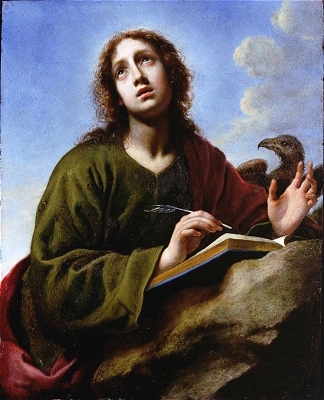ST. JOHN WRITING THE BOOK OF REVELATION
Carlo Dolci, Italian ,1616-1686
SN137, Oil on Copper, c. 1647From "The Pages"
ARTIST:
Carlo Dolci was born in Florence and as a child prodigy trained there with Jacopo Vignali
beginning in 1625. He was renowned for his fine portraiture, and became a member of the
Accademia del Disegno. He painted a large number of works for private patrons and several
paintings commissioned by the Medici family hang in the Palazzo Pitti.
SUBJECT:
St. John, brother of James the Apostle and Evangelist, was the youngest and best beloved
of the twelve apostles. John was present at the Crucifixion together with the three Marys,
and Christ asked him to care for his mother, Mary. She is said to have lived with John
until her death. After her death, John traveled about Judea with St. Peter, preaching the
gospel. He suffered great persecution from Emperor Domitian and was exiled to the
island of Patmos, the place of his Revelation. At a very advanced age he died in Ephesus,
where it was said he dug his own grave in the shape of a cross. |
|
 |
PAINTING:
This small, devotional work is exquisitely painted, and the youthful saint’s ecstatic
expression with upraised eyes and opened mouth are all typical stylistic details. St. John
is shown with his attribute , the eagle, symbol of divine inspiration, and a book, gazing
upward listening to his divine message.
Dolci’s painting of St John is considered Florentine Baroque or Mannerist. He chose
to paint saints in adoration or ecstasy, and his work is known for passionate religiosity
& sensitively virtuoso technique. This piece is typical of his idealized saints, done
with imperceptible brushwork.
HISTORIC CONTEXT:
The deeply religious context of Dolci’s work was popular with the clergy of the
Catholic Church and supported the Counter Reformation. He was favored by the Medicis and
his work reflected the religiosity of the Court. Intended for aristocratic circles,
Dolci’s work enjoyed an international acclaim in his own lifetime.
ringlingdocents.org
|